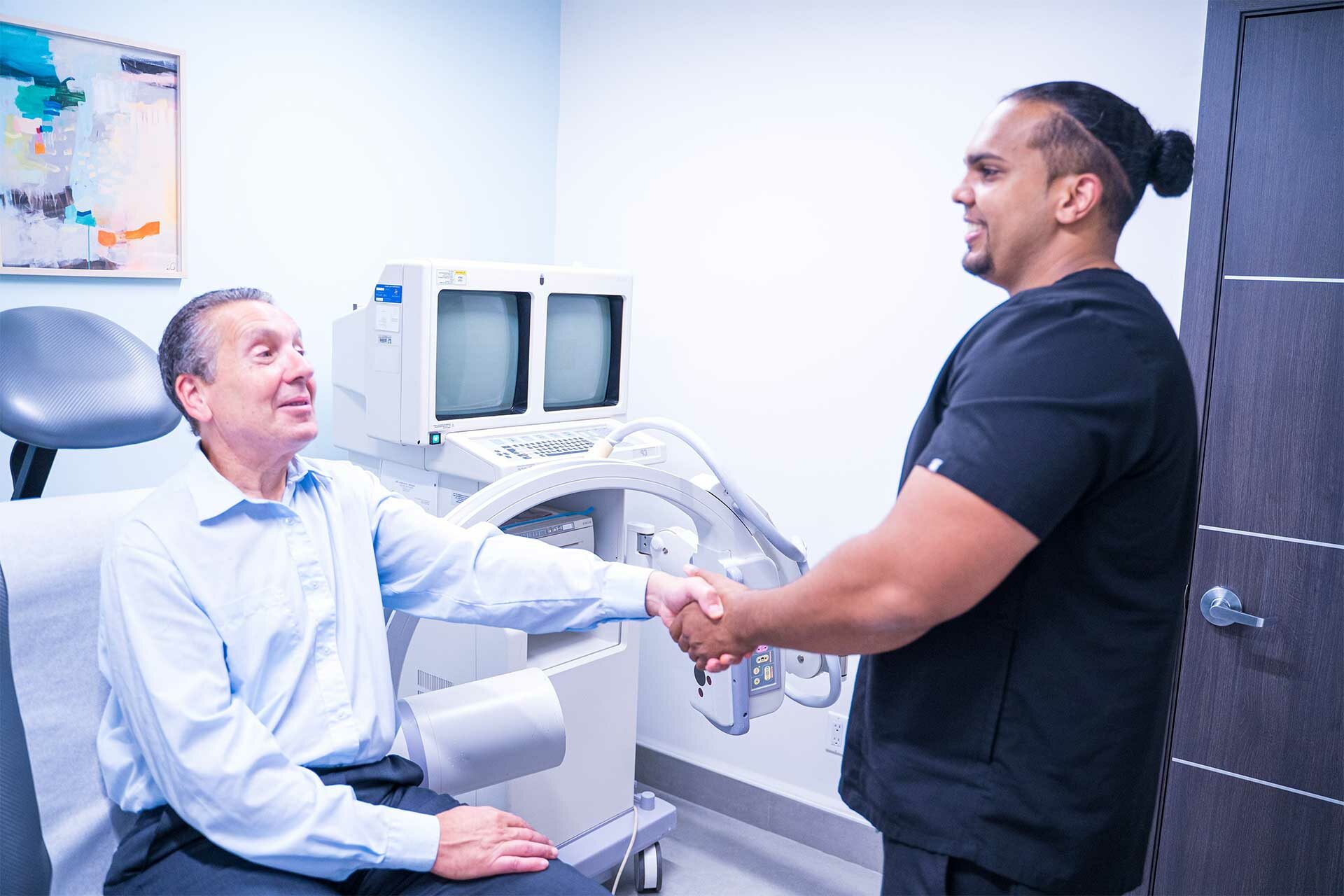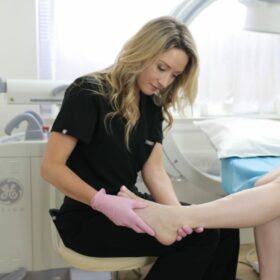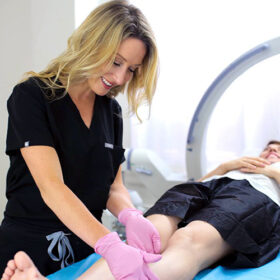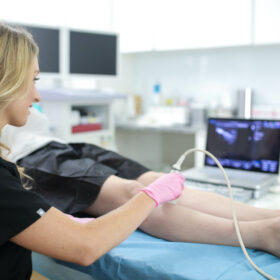Varicose veins are an extremely common problem. You may think you’re alone in struggling with varicose veins, but you’re not. Millions of people in the United States suffer from varicose veins and spider veins, especially women and older individuals. Most people get pretty good at concealing varicose veins underneath dresses and pants, or avoiding social events that may involve wearing short dresses. That’s why you don’t realize how common varicose veins are.
In addition to being extremely common, varicose veins are also super easy to treat — we’re talking about simple, in-office procedures that conclude within 30 to 60 minutes and involve little to no downtime. Considering how easily you can treat varicose veins, why would you continue dealing with these ugly, dilated, bulging leg veins? Visit Vein Treatment Clinic — we have offices in New York, New Jersey, California, and Washington, DC — and liberate yourself from varicose veins. Please schedule an appointment at your nearest vein treatment clinic.
Conservative Treatments For Varicose Veins
Before considering invasive treatments, many patients opt for conservative management to alleviate their varicose vein symptoms. These non-invasive approaches can include lifestyle changes and the use of compression stockings.
Compression Stockings
Wearing graduated compression stockings can help improve blood flow in the legs by applying pressure to the veins. They essentially push accumulated blood toward the heart, alleviating some of the symptoms of blood accumulation in the leg veins. They are readily available and can provide relief from mild varicose vein symptoms. However, you should ideally wear custom-fitted compression stockings acquired through vein doctors.
Lifestyle Changes
Simple lifestyle adjustments can make a significant difference. Regular exercise, elevating your legs when resting, and avoiding prolonged periods of sitting or standing can help alleviate symptoms. The following is a comprehensive list of lifestyle changes to manage varicose veins:
- Wear compression stockings.
- Stay physically active.
- Elevate your legs when resting.
- Avoid prolonged periods of sitting or standing.
- Maintain a healthy body weight.
- Follow a low-salt diet.
- Stay hydrated.
- Avoid high heels and tight clothing.
- Exercise regularly.
- Rotate your ankles and flex your calf muscles periodically.
- Avoid crossing your legs when sitting.
- Avoid hot baths or saunas.
- Stay away from smoking and excessive alcohol consumption.
Minimally Invasive Treatment Options
Sclerotherapy
- What It Is: Sclerotherapy is a popular procedure for treating spider veins and small varicose veins. It involves injecting a solution directly into the affected veins, causing them to turn into hardened scar tissues, collapse and eventually fade away.
- Ideal Candidates: Sclerotherapy is ideal for individuals with smaller varicose veins and spider veins. It’s not suitable for treating underlying venous insufficiency.
Endovenous Laser Ablation (EVLA)
- What It Is: EVLA is a minimally invasive laser treatment that targets and closes off the affected veins using laser energy. It is highly effective in treating larger varicose veins.
- Ideal Candidates: EVLA is suitable for individuals with larger varicose veins that are causing discomfort and pain. It can also treat underlying venous insufficiency.
Radiofrequency Ablation
- What It Is: Similar to EVLA, radiofrequency ablation uses radiofrequency energy to heat and seal off the problematic veins. It’s particularly effective for treating veins with irregular shapes.
- Ideal Candidates: RFA is a versatile treatment option suitable for various types of varicose veins, and it can also treat underlying chronic venous insufficiency.
VenaSeal
- What It Is: VenaSeal is a unique treatment that involves the use of a medical adhesive to seal off the affected veins. It is highly effective and minimizes discomfort during and after the procedure. In fact, you don’t even have to wear compression stockings after VenaSeal.
- Ideal Candidates: VenaSeal is great for individuals who prefer a painless experience, especially those who don’t want to risk thermal energy while treating varicose veins.
ClariVein
- What It Is: ClariVein is a minimally invasive procedure that combines mechanical and chemical methods to close off the affected veins. It is often chosen for its minimal discomfort and short recovery time, and it’s particularly suitable for treating tortuous veins.
- Ideal Candidates: ClariVein is a suitable option for those with medium-sized varicose veins, especially those that are extremely twisted and tortuous, and thus can’t be treated with RFA.
Ambulatory Phlebectomy
- What It Is: Ambulatory phlebectomy is a surgical procedure that involves the physical removal of varicose veins through tiny incisions. It is typically used for larger veins. It’s a cosmetic procedure, so it can remove varicose veins but doesn’t treat underlying vein disease.
- Ideal Candidates: Ambulatory phlebectomy is recommended for individuals with extensive or bulging varicose veins.
How Vein Treatment Clinic Approaches Varicose Vein Treatment
Step 1. Diagnostic Ultrasound
Before any treatment is recommended, we perform a thorough duplex ultrasound to diagnose the root cause of your varicose veins. This step is crucial in tailoring a personalized treatment plan that addresses your specific condition.
Step 2. Customized Treatment Plan
Based on the ultrasound results and a comprehensive evaluation of your symptoms, our vein doctors curate a treatment plan that best suits your needs. We prioritize minimally invasive treatments whenever possible to ensure a comfortable and efficient experience for our patients. If you are diagnosed with chronic venous insufficiency, we perform minimally invasive procedures for the underlying vein disease before removing superficial varicose veins.
Step 3. Treatment Execution
Once your treatment plan is established, our experienced medical staff will perform the selected procedure with precision and care. We ensure that you are well-informed about each step of the process and that your comfort is a top priority. Most minimally invasive varicose vein treatments are performed under local anesthesia, involve a few injections or small incisions on the skin’s surface, and conclude within 30 to 60 minutes.
Step 4. Follow-Up and Monitoring
After your treatment, we continue to monitor your progress and provide any necessary follow-up care to ensure the best possible outcome. You can resume your daily activities immediately, but avoid strenuous workouts for a few days. You should also return for follow-up evaluations and sessions as recommended to ensure optimal relief from varicose veins.
Benefits of Minimally Invasive Varicose Vein Treatments:
- Quick and Convenient: Minimally invasive procedures typically require minimal downtime, allowing you to resume your daily activities quickly.
- Reduced Pain and Discomfort: Patients often experience less pain and discomfort during and after minimally invasive treatments compared to surgery.
- Minimal Scarring: Incisions made during these procedures are small, resulting in minimal scarring and improved cosmetic outcomes.
- Effective and Long-Lasting: Minimally invasive treatments are highly effective in treating varicose veins, with long-lasting results.
- Improved Circulation: Treating varicose veins not only enhances the appearance of your legs but also improves overall blood circulation.
When to Seek Treatment
Varicose veins should not be ignored, as they can worsen over time and lead to more severe complications if left untreated. It’s essential to consult with a vein specialist if you experience:
- Persistent pain or discomfort in your legs.
- Swelling, redness, or warmth over the affected veins.
- Leg ulceration, i.e., non-healing leg wounds.
- Bleeding from varicose veins.
- If varicose veins affect your quality of life or self-confidence.
FAQs About Varicose Vein Treatment
What are varicose veins?
Varicose veins are enlarged, twisted, and swollen veins that typically appear in the legs. They are caused by a condition known as venous insufficiency, which occurs when the valves in the veins weaken or malfunction. These valves usually keep blood flowing in one direction, towards the heart. When they fail, blood pools in the veins, causing them to become enlarged.
What are the symptoms of varicose veins?
Varicose veins are more than just a cosmetic concern; they can also lead to various uncomfortable symptoms, including:
- Pain and Aching: Many individuals with varicose veins experience aching, throbbing, or pain in the legs, especially after prolonged periods of standing or sitting.
- Swelling: The affected leg may swell, particularly around the ankles and feet.
- Itching: Some people with varicose veins may experience itching and discomfort over the affected area.
- Leg Cramps: Painful leg cramps, particularly at night, can also be a symptom of varicose veins.
- Skin Changes: Over time, the skin around the affected veins may become discolored, dry, and prone to ulcers.
Can dermatologists treat varicose veins?
While dermatologists can diagnose varicose veins, they typically refer patients to vein specialists for treatment. Vein specialists have the expertise and equipment needed for effective varicose vein treatments. Dermatologists are specialists in skin conditions, and while varicose veins can produce superficial skin-related symptoms, they’re actually a vascular condition.
Do new veins develop after treatment?
Minimally invasive treatments close off the affected veins permanently. However, it is possible for new varicose veins to develop over time. Regular follow-ups with your vein doctor can help address any new developments. You can also implement lifestyle changes like wearing compression stockings and exercising regularly to minimize the risk of varicose vein recurrence.
What are bulging veins behind the knee?
Bulging veins behind the knee are often a symptom of varicose veins. These veins may appear enlarged and twisted due to the pooling of blood caused by venous insufficiency.
Visit VTC For Varicose Vein Treatments
Varicose veins can be more than just a cosmetic concern; they can cause discomfort and affect your overall quality of life. Thankfully, there are highly effective, minimally invasive treatments available, such as those offered by Vein Treatment Clinic. By seeking early intervention and consulting with a board-certified vein specialist, you can regain your comfort, confidence, and leg health. You can visit your nearest vein treatment clinic in New York City, Long Island, New Jersey, San Jose and San Diego in California, or Maryland. Please schedule an appointment.












